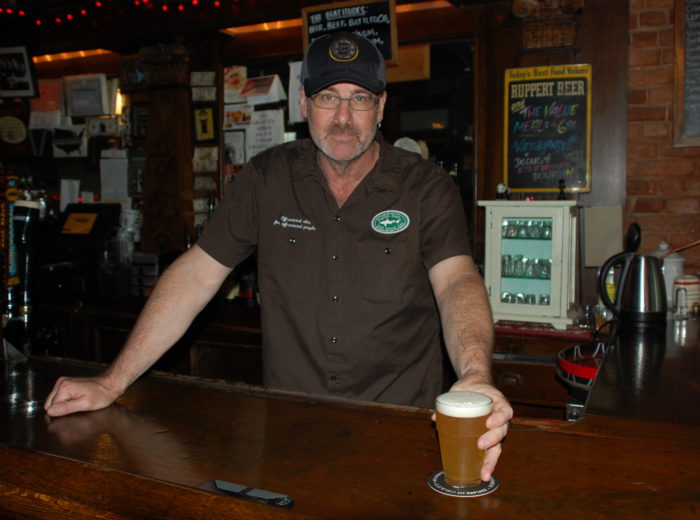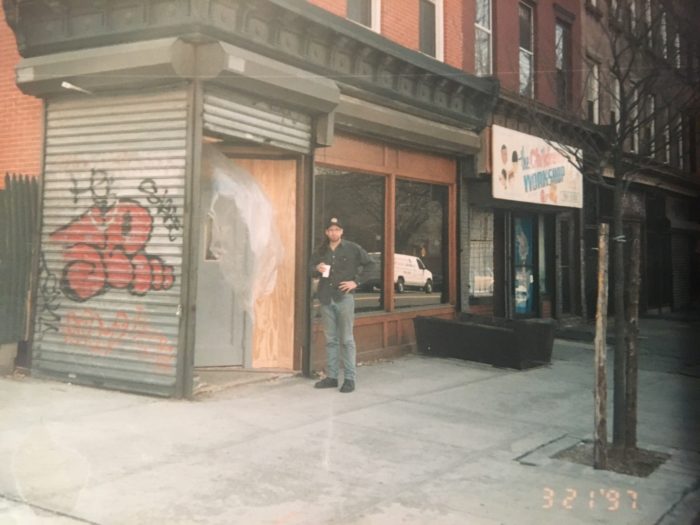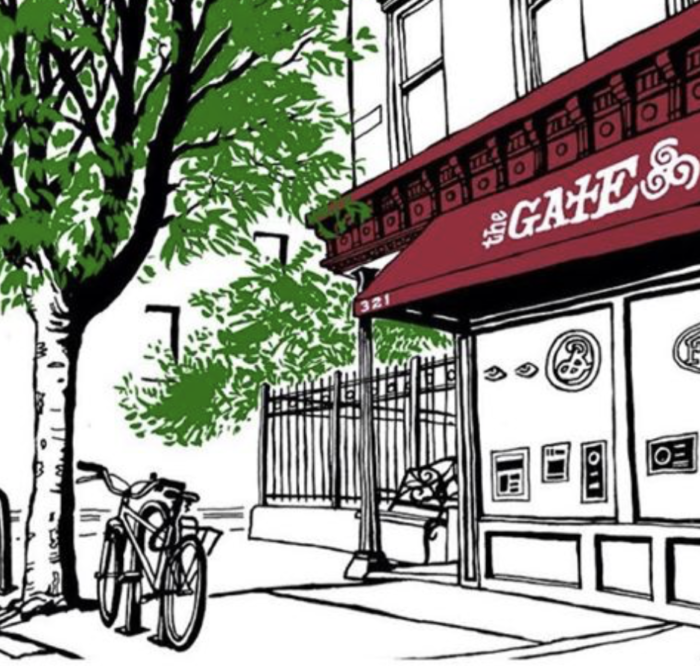A Craft Beer Pioneer’s Secrets of Survival
As Brooklyn's The Gate celebrates its 20th anniversary, owner Bobby Gagnon tells how he endured in a changing borough
Gagnon serves up a brew from Brooklyn's Grimm Artisanal Ales (Photo by Steve Koepp)
As a small businessman, Bobby Gagnon is a survivor. Not the kind just grimly hanging on, but the sort who cheerfully throws open his doors every day for another round of serving the neighbors. At a time in Brooklyn when so many locally-run shops have been supplanted by real-estate offices and national chains, his Park Slope craft-beer bar, The Gate, at 321 5th Ave., has endured for 20 years. He and his fans will be celebrating the milestone tonight starting at 7 p.m., when some of the prices will be rolled back to 1997 levels.
Back in the days when Gagnon opened the bar, 5th Avenue was a “forlorn” stretch, he recalls, with sparse foot traffic after dark. Now the avenue is so prosperous that shopkeepers have a different concern: they worry that wealth, and rising rents, will push them out.
How did Gagnon make it this far? Much of his success comes from his early bet on an epic cultural trend: the craft-beer movement. So too is having a great spot on a corner, with a patio on the side, and popular events like trivia night. But another key is Gagnon’s immersion in the neighborhood. A Boston native, he and his wife live right around the corner from the bar. Their son and daughter have risen up through the neighborhood’s public schools. Gagnon can talk with the teachers over the bar, not just in parent-teacher conferences.
Likewise, Gagnon grew up in the business with the community of craft brewers as they got their start, sharing advice and camaraderie. Today he sells about 24 kegs a week, supporting the pioneer brands like Brooklyn Brewery, but always looking for worthy newcomers. The Bridge talked with Gagnon to hear about the secrets of his survival.
1. What was your vision of the place?
The idea was to open a draught craft-beer-focused pub. A “local,” in the Irish parlance.
2. How'd you know craft beers would be a big thing?
I didn’t! I bartended in a famed bar in L.A. that featured 300 beers. I grew up knowing beer only as largely tasteless adjunct lager. In that bar I discovered the complexity and the possibilities in beer. Mind blown. I began devouring anything and everything new. When I moved to New York City, I soon met Dave Brodrick, who was in the earliest stages of what would eventually be the legendary Blind Tiger Ale House. We worked together and he and I talked and drank beer. A lot. In craft beer, I was finding that those who were into it, who were fans, were ardent and curious. It was that excitement that started the pioneers of craft-beer bars in New York City. The only knowing was guessing, really, that this could be the right direction.
3. What were your biggest challenges?

Gagnon at the bar as it was refurbished before opening in 1997 (Photo courtesy of Bobby Gagnon)
The challenges that were largest were in the first two years. We opened on credit cards, piggy banks, and begging Uncle Jim to kick in. Any small business owner will tell you those first debt-soaked days, weeks, months, years, are truly frightening. At that time, Fifth Avenue was largely shuttered. There was no nightlife, no foot traffic after dark. Pioneer territory. We were one of about a half-dozen craft-beer bars in the entire city. Those were the days when Sam Calagione of Dogfish Head [Craft Brewery] and I sat at this bar for his first-ever Brooklyn beer event, consisting of four kegs he brought from Delaware in his pickup and about nine patrons, and wondered aloud if this was all going to fly.
4. Who was your clientele in those days?
Those who came to us were not what we call today beer geeks. Let’s just say there were zero lines around any blocks anywhere to buy four cans of beer. We were beer ambassadors. We stocked and talked. We put beers in hands and told those who were willing and curious that they should absolutely try this stuff. We explained, educated, and told back stories. The real work in early retail craft was in variety. “Here, now try this one. Am I right?” That kind of thing. It might sound odd today, but ours was a time of word-of-mouth and print. Google? Nope. They started up a year and a half after we opened our doors.
5. Is it hard to choose your beers now, with so many offerings?
Many a sales rep can attest to the difficulty there. We, like most craft-beer bars, are rotators. At The Gate I have three static lines. The other 21 are rotating. Always. With IPAs being such a dominant style now, and the fact that shelf life for this style is limited, there is a dance. The ordering levels must be careful to ensure timely serving and keep the beer as close to the brewers’ intent as possible. New breweries crop up constantly now. We are in the mid-5,000s now nationwide, I believe. More breweries now than at any other time in our history. They all need to move beer, and this is an issue the industry as a whole is facing. I have said often in the past five or six years, back when there were half as many breweries, that if I doubled my lines, I still couldn’t make everyone happy.
6. How has the changing neighborhood affected you?

The Gate beckons customers from a well-trafficked spot at the corner of 5th Avenue and 3rd Street (Illustration courtesy of The Gate)
The neighborhood has changed much. In the early days, this area was considered unsafe. We turned on the lights and kept one corner lit, and people started to find us. We are a pub. We welcome all comers. We meet new neighborhood people constantly. The demographics change, the new buildings keep going up, new neighbors come check us out, old neighbors come back. We still remain us. If you are comfortable here, that is all I hope to offer. Have a seat. And a kickass beer!
7. How have you dealt with rising rent?
One of the key ingredients in NYC success and longevity is the lot itself. Sure, location-location-location. But truly the rent is tied intimately to your ability to survive. We rent our space. Rent means lease, lease terms, negotiations. This is always existing on the horizon. I never forget how fortunate it is to be here. Still. The city is littered with viable small businesses forced out, or out of business, due merely to rent. I’m still here. The ceiling hasn’t hit me in the head yet.
8. What have been your biggest joys in running this place?
The joy is in opening my doors each day to my patrons, serving them well, and they leave here happy. It is a service industry. In the greatest city on earth. At this 20-year mark, I still love what I do. A bar is, should be, like a home. Or more accurately, a room in a larger home. A place to sit a spell and meet, ruminate, discuss, argue, laugh, cry, celebrate. I am thrilled to provide that.
9. What kind of events have happened here?
Twenty years of history. We have many [customers] here who were here in the first couple years we opened. We have been through snowstorms, hurricanes, a tornado, 9/11, the blackout, weddings, births, deaths, celebrations, five elections, you name it. And been open through it all. We open unless we absolutely cannot. And the cannot has been rare.
10. Do you plan to run this place for another 20 years?
If another 20 years is in the cards, I am in. I do hope, though, I can still throw kegs around. That part is keeping me young. As far as changes, there will be tweaks, upgrades, new product lines, but The Gate will remain as it began. No frills, gimmicks, pretense. Here comes Decade Three and I am ready to rock.










